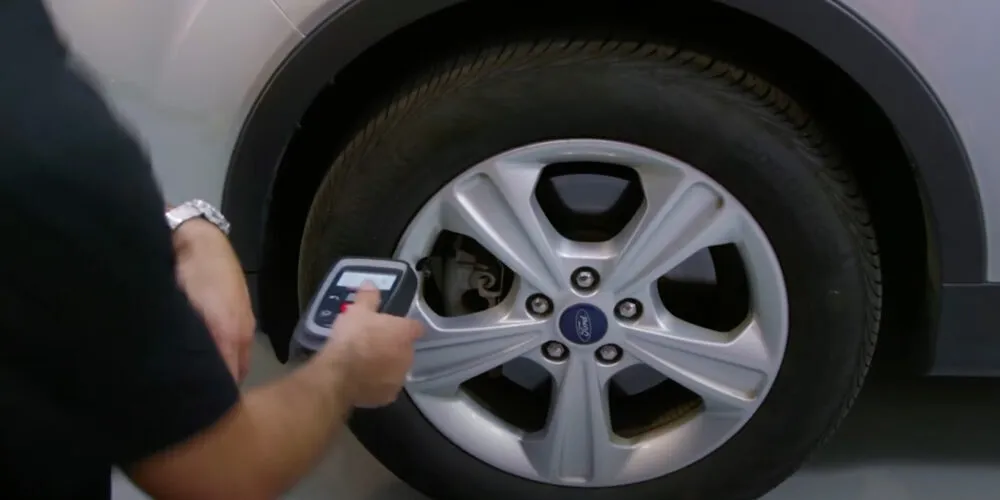Tire sensors, also known as TPMS (Tire Pressure Monitoring System) sensors, play a vital role in keeping your vehicle safe on the road. They monitor the air pressure in your tires and alert you if it drops below a certain level. But where exactly are these tire sensors located, and how do they work? In this article, we will explore everything you need to know about where is the tire sensor located, their location, and why they are important.
What is a Tire Sensor?
Before we delve into the location, it’s important to understand what a tire sensor is. A tire sensor is a small device inside your tire that monitors the air pressure. When the pressure drops too low, the sensor sends a signal to your vehicle’s computer system. This triggers a warning light on your dashboard, letting you know that one or more of your tires need attention.
Why Tire Sensors Matter
Tire sensors are essential for maintaining your vehicle’s safety and efficiency. Properly inflated tires help with better fuel economy, improve handling, and reduce the risk of tire blowouts. Underinflated tires can wear out more quickly and may lead to dangerous driving conditions. That’s why having a functioning tire sensor is crucial.
Where is the Tire Sensor Located?
Now that we know what a tire sensor is and why it’s important, let’s find out where it’s located.
1. Inside the Tire
The tire sensor is located inside each tire, attached to the valve stem. The valve stem is the small metal or rubber tube that you see poking out of your wheel. This is where you inflate the tire with air. The sensor is usually mounted on the inner part of the valve stem, inside the tire. This placement allows the sensor to accurately monitor the air pressure within the tire.
2. On the Valve Stem
The valve stem itself is a key part of the tire sensor system. It’s where the sensor is attached, and it’s also the part you interact with when adding air to your tires. The sensor reads the air pressure through the valve stem and sends the information to your vehicle’s computer system.
3. Part of the Wheel Assembly
The tire sensor is an integral part of the wheel assembly. It’s designed to stay in place even when the tire is spinning at high speeds. This ensures that the sensor can constantly monitor the pressure and provide real-time information to the driver. It’s a small, durable device built to withstand the harsh conditions inside the tire.
How Do Tire Sensors Work?
Understanding how tire sensors work can help you appreciate their role in your vehicle’s safety.
1. Monitoring Air Pressure
The primary function of a tire sensor is to monitor the air pressure inside the tire. It uses a small battery to power itself and measures the pressure continuously. If the pressure drops below a certain threshold, the sensor detects this change.
2. Sending Signals to the Computer
Once the sensor detects low pressure, it sends a wireless signal to your vehicle’s computer system. This signal is then processed, and if the pressure is indeed low, the system triggers a warning light on your dashboard. This light is usually a small icon that looks like an exclamation mark inside a horseshoe, representing a tire.
3. Alerting the Driver
The dashboard warning light is the final step in the tire sensor’s job. It alerts you to check your tires and add air if necessary. Ignoring this warning can lead to unsafe driving conditions, so it’s important to take action as soon as you see it.
Maintaining Your Tire Sensors
Like any other part of your vehicle, tire sensors need proper care to function correctly. Here’s how you can maintain them:
1. Regular Tire Checks
It’s a good idea to check your tire pressure regularly, even if your sensors are working fine. This ensures that your tires are always properly inflated and reduces the chances of sensor failure.
2. Avoid Harsh Conditions
While tire sensors are built to withstand tough conditions, extreme temperatures or harsh driving environments can still affect them. Try to avoid driving over rough terrain or exposing your tires to very hot or cold conditions for extended periods.
3. Replace Sensors When Needed
Tire sensors have a limited lifespan, usually around 5 to 7 years. If your sensor fails or the battery dies, you’ll need to replace it. It’s best to do this as soon as possible to keep your vehicle safe.
Common Tire Sensor Problems
Sometimes, tire sensors can experience issues. Here are a few common problems and how to address them:
1. False Warnings
Occasionally, a tire sensor might trigger a warning even if the tire pressure is fine. This can happen due to a weak battery in the sensor or interference from other devices. If this occurs, check your tire pressure manually. If the pressure is correct, the sensor may need to be recalibrated or replaced.
2. Sensor Failure
A failed sensor won’t send any signals to your vehicle’s computer system, meaning you won’t get a warning if your tire pressure drops. If you notice that your dashboard warning light doesn’t come on even when a tire is low, it could be a sign that the sensor has failed.
3. Battery Issues
Tire sensors are powered by small batteries that eventually run out. When the battery dies, the sensor stops working. Replacing the sensor is usually the only solution when this happens.
Conclusion
Tire sensors are a small but crucial part of your vehicle. Located inside the tire and attached to the valve stem, they monitor air pressure and help keep you safe on the road. By understanding where the tire sensor is located and how it works, you can better maintain your vehicle and avoid potential problems. Regular checks and proper care will ensure that your Zee’s new and used tires continue to function properly, keeping you and your passengers safe.


